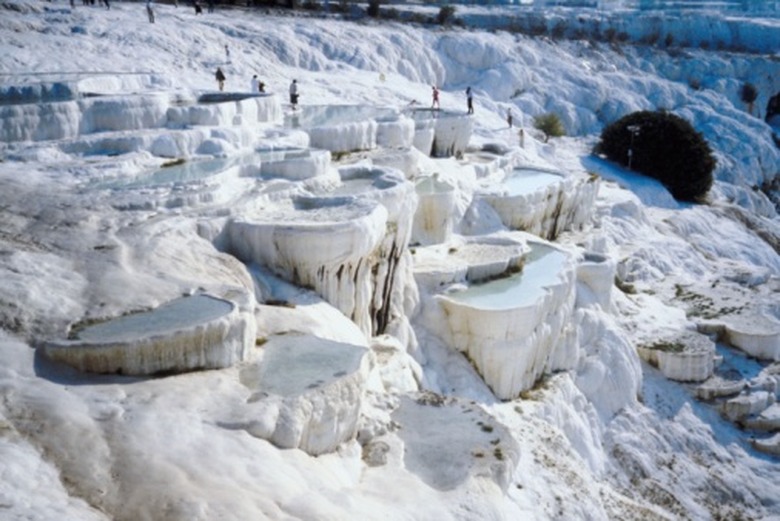Limestone Chemical Components
Limestone is a sedimentary rock composed mainly of calcium carbonate (CaCO3). However, it can also contain magnesium carbonate, clay, iron carbonate, feldspar, pyrite and quartz in minor quantities, according to the Encyclopaedia Britannica. Most types of limestone have a granular texture. Often, the grains are microscopic fragments of fossil animal shells. Calcite, aragonite, travertine, tufa, caliche, chalk, sparite, and micrite are some varieties of limestone.
Calcium Carbonate
Calcium Carbonate
Calcium carbonate comprises more than 4 percent of the earth's crust, according to the Industrial Minerals Association of North America. Calcium carbonate reacts with acids, producing carbon dioxide. The compound is also the main component of stalactites and stalagmites, which are cave formations created by dripping water. Calcium carbonate is widely used in the paper, plastics, paints and coatings industries. It can represent as much as 30 percent of paints by weight. Calcium carbonate is also important in the construction industry as an ingredient of cement.
Magnesium Carbonate
Magnesium Carbonate
Magnesium carbonate is a compound that mostly occurs in nature as the mineral magnesite. It is also an important component of dolomitic or magnesian limestone, ranging from 4.4 percent to 22 percent of these limestones. Dolomitic limestone is used in the steel industry. It is used as a neutralizing agent in water treatment and as a source of lime and magnesia in the glass fiber industry.
Iron Carbonate
Iron Carbonate
Also called siderite, iron carbonate is a compound that can be found in limestone but only in small quantities. It is often associated with calcium carbonate. Iron carbonate is a valuable source of iron, containing 48 percent of the element. It is often found in sedimentary deposits and in metamorphosed sedimentary rocks. In its pure state, it has a vitreous, silky appearance.
Other Components
Other Components
Minor chemical components of limestone include clay, feldspar, pyrite and quartz. Feldspar crystallizes from magma, thus is more commonly found in volcanic rocks. Feldspar is widely used in the ceramic, adhesive and glass industries. Limestone containing pyrite is rare, but has been found Padappakara, India. Quartz and clay are more commonly associated with limestone.
References
- Encyclopaedia Britannica: Limestone
- "Sedimentary Rocks: A Record of Earth's History"; Darlene R. Stille; 2008
- Mindat.org: Siderite
Cite This Article
MLA
Zinni, Yasmin. "Limestone Chemical Components" sciencing.com, https://www.sciencing.com/limestone-chemical-components-8044801/. 24 April 2017.
APA
Zinni, Yasmin. (2017, April 24). Limestone Chemical Components. sciencing.com. Retrieved from https://www.sciencing.com/limestone-chemical-components-8044801/
Chicago
Zinni, Yasmin. Limestone Chemical Components last modified August 30, 2022. https://www.sciencing.com/limestone-chemical-components-8044801/
